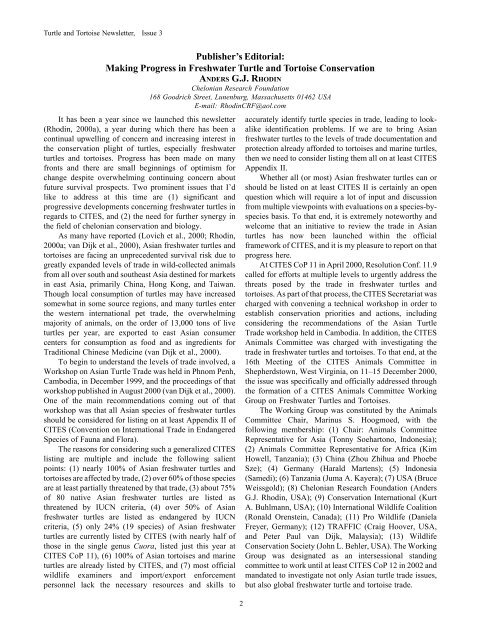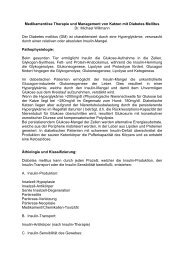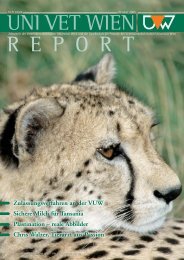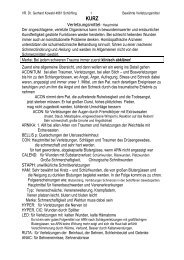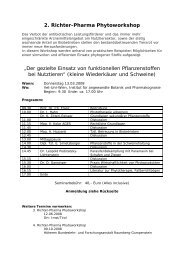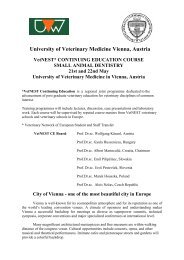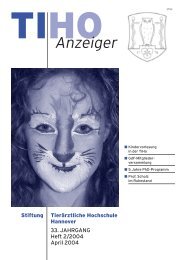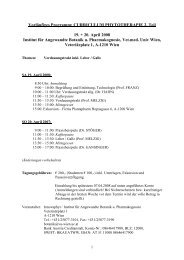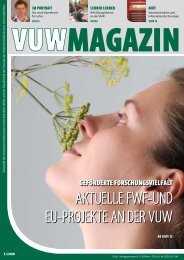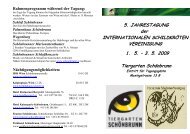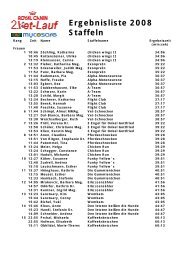Turtle and Tortoise Newsletter - VET-MAGAZIN.com
Turtle and Tortoise Newsletter - VET-MAGAZIN.com
Turtle and Tortoise Newsletter - VET-MAGAZIN.com
Create successful ePaper yourself
Turn your PDF publications into a flip-book with our unique Google optimized e-Paper software.
<strong>Turtle</strong> <strong>and</strong> <strong>Tortoise</strong> <strong>Newsletter</strong>, Issue 3Publisher’s Editorial:Making Progress in Freshwater <strong>Turtle</strong> <strong>and</strong> <strong>Tortoise</strong> ConservationANDERS G.J. RHODINChelonian Research Foundation168 Goodrich Street, Lunenburg, Massachusetts 01462 USAE-mail: RhodinCRF@aol.<strong>com</strong>It has been a year since we launched this newsletter(Rhodin, 2000a), a year during which there has been acontinual upwelling of concern <strong>and</strong> increasing interest inthe conservation plight of turtles, especially freshwaterturtles <strong>and</strong> tortoises. Progress has been made on manyfronts <strong>and</strong> there are small beginnings of optimism forchange despite overwhelming continuing concern aboutfuture survival prospects. Two prominent issues that I’dlike to address at this time are (1) significant <strong>and</strong>progressive developments concerning freshwater turtles inregards to CITES, <strong>and</strong> (2) the need for further synergy inthe field of chelonian conservation <strong>and</strong> biology.As many have reported (Lovich et al., 2000; Rhodin,2000a; van Dijk et al., 2000), Asian freshwater turtles <strong>and</strong>tortoises are facing an unprecedented survival risk due togreatly exp<strong>and</strong>ed levels of trade in wild-collected animalsfrom all over south <strong>and</strong> southeast Asia destined for marketsin east Asia, primarily China, Hong Kong, <strong>and</strong> Taiwan.Though local consumption of turtles may have increasedsomewhat in some source regions, <strong>and</strong> many turtles enterthe western international pet trade, the overwhelmingmajority of animals, on the order of 13,000 tons of liveturtles per year, are exported to east Asian consumercenters for consumption as food <strong>and</strong> as ingredients forTraditional Chinese Medicine (van Dijk et al., 2000).To begin to underst<strong>and</strong> the levels of trade involved, aWorkshop on Asian <strong>Turtle</strong> Trade was held in Phnom Penh,Cambodia, in December 1999, <strong>and</strong> the proceedings of thatworkshop published in August 2000 (van Dijk et al., 2000).One of the main re<strong>com</strong>mendations <strong>com</strong>ing out of thatworkshop was that all Asian species of freshwater turtlesshould be considered for listing on at least Appendix II ofCITES (Convention on International Trade in EndangeredSpecies of Fauna <strong>and</strong> Flora).The reasons for considering such a generalized CITESlisting are multiple <strong>and</strong> include the following salientpoints: (1) nearly 100% of Asian freshwater turtles <strong>and</strong>tortoises are affected by trade, (2) over 60% of those speciesare at least partially threatened by that trade, (3) about 75%of 80 native Asian freshwater turtles are listed asthreatened by IUCN criteria, (4) over 50% of Asianfreshwater turtles are listed as endangered by IUCNcriteria, (5) only 24% (19 species) of Asian freshwaterturtles are currently listed by CITES (with nearly half ofthose in the single genus Cuora, listed just this year atCITES CoP 11), (6) 100% of Asian tortoises <strong>and</strong> marineturtles are already listed by CITES, <strong>and</strong> (7) most officialwildlife examiners <strong>and</strong> import/export enforcementpersonnel lack the necessary resources <strong>and</strong> skills to2accurately identify turtle species in trade, leading to lookalikeidentification problems. If we are to bring Asianfreshwater turtles to the levels of trade documentation <strong>and</strong>protection already afforded to tortoises <strong>and</strong> marine turtles,then we need to consider listing them all on at least CITESAppendix II.Whether all (or most) Asian freshwater turtles can orshould be listed on at least CITES II is certainly an openquestion which will require a lot of input <strong>and</strong> discussionfrom multiple viewpoints with evaluations on a species-byspeciesbasis. To that end, it is extremely noteworthy <strong>and</strong>wel<strong>com</strong>e that an initiative to review the trade in Asianturtles has now been launched within the officialframework of CITES, <strong>and</strong> it is my pleasure to report on thatprogress here.At CITES CoP 11 in April 2000, Resolution Conf. 11.9called for efforts at multiple levels to urgently address thethreats posed by the trade in freshwater turtles <strong>and</strong>tortoises. As part of that process, the CITES Secretariat wascharged with convening a technical workshop in order toestablish conservation priorities <strong>and</strong> actions, includingconsidering the re<strong>com</strong>mendations of the Asian <strong>Turtle</strong>Trade workshop held in Cambodia. In addition, the CITESAnimals Committee was charged with investigating thetrade in freshwater turtles <strong>and</strong> tortoises. To that end, at the16th Meeting of the CITES Animals Committee inShepherdstown, West Virginia, on 11–15 December 2000,the issue was specifically <strong>and</strong> officially addressed throughthe formation of a CITES Animals Committee WorkingGroup on Freshwater <strong>Turtle</strong>s <strong>and</strong> <strong>Tortoise</strong>s.The Working Group was constituted by the AnimalsCommittee Chair, Marinus S. Hoogmoed, with thefollowing membership: (1) Chair: Animals CommitteeRepresentative for Asia (Tonny Soehartono, Indonesia);(2) Animals Committee Representative for Africa (KimHowell, Tanzania); (3) China (Zhou Zhihua <strong>and</strong> PhoebeSze); (4) Germany (Harald Martens); (5) Indonesia(Samedi); (6) Tanzania (Juma A. Kayera); (7) USA (BruceWeissgold); (8) Chelonian Research Foundation (AndersG.J. Rhodin, USA); (9) Conservation International (KurtA. Buhlmann, USA); (10) International Wildlife Coalition(Ronald Orenstein, Canada); (11) Pro Wildlife (DanielaFreyer, Germany); (12) TRAFFIC (Craig Hoover, USA,<strong>and</strong> Peter Paul van Dijk, Malaysia); (13) WildlifeConservation Society (John L. Behler, USA). The WorkingGroup was designated as an intersessional st<strong>and</strong>ing<strong>com</strong>mittee to work until at least CITES CoP 12 in 2002 <strong>and</strong>m<strong>and</strong>ated to investigate not only Asian turtle trade issues,but also global freshwater turtle <strong>and</strong> tortoise trade.


